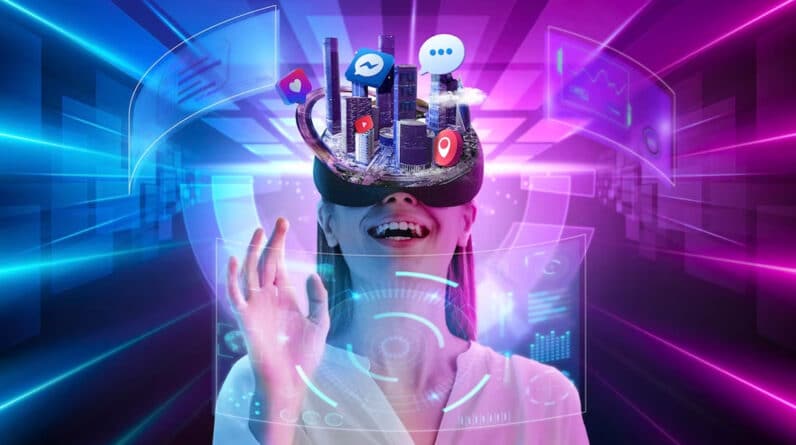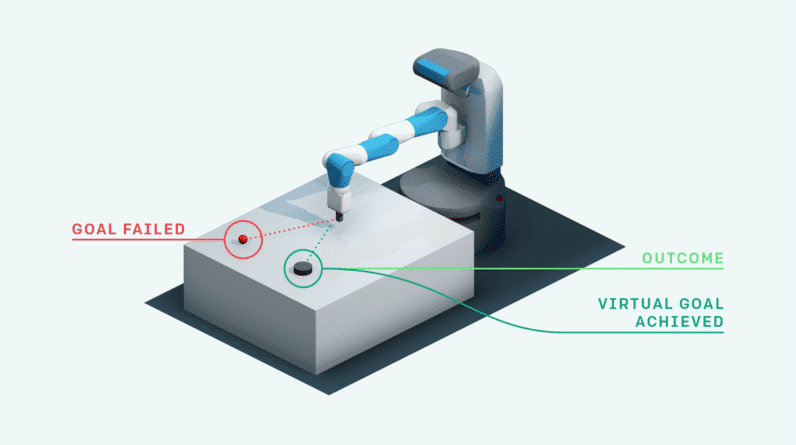In the ever-evolving world of technology, the integration of artificial intelligence (AI) into human-computer interaction is revolutionizing user interfaces. With AI algorithms becoming increasingly sophisticated, the boundaries between man and machine are becoming blurred, as AI systems are able to understand and respond to human needs in ways that were once unimaginable. This article explores the fascinating advancements in AI and human-computer interaction, and how these advancements are shaping the way we interact with technology on a daily basis.

What is Human-Computer Interaction
Definition of Human-Computer Interaction
Human-Computer Interaction (HCI) refers to the study and practice of designing, implementing, and evaluating user interfaces between humans and computers. It focuses on creating interactive systems that are user-friendly, efficient, and intuitive to use. HCI encompasses various aspects such as understanding user needs and behaviors, designing interfaces that facilitate efficient interaction, and evaluating the effectiveness of these interfaces.
Objectives of Human-Computer Interaction
The objectives of HCI are to enhance the usability and user experience of computer systems. HCI aims to create interfaces that are intuitive, efficient, and enjoyable for users. It seeks to understand human capabilities, limitations, and behaviors to design interfaces that accommodate these factors. The ultimate goal of HCI is to create user interfaces that are seamlessly integrated into the daily lives of individuals, enabling them to interact with technology effortlessly.
Importance of Human-Computer Interaction
Human-Computer Interaction is of paramount importance in today’s digital age. Effective HCI enables users to easily navigate and interact with complex systems, ultimately improving productivity, efficiency, and satisfaction. It ensures that technology is accessible to all users, regardless of their age, abilities, or technological literacy. HCI plays a crucial role in the success of software applications, websites, and other digital platforms by ensuring that user needs and preferences are met. By understanding user behavior and designing intuitive interfaces, HCI optimizes the user experience and ultimately contributes to the success of digital products.
Evolution of User Interfaces
Early User Interfaces
In the early days of computing, user interfaces primarily relied on command-line interfaces, where users input commands using text-based codes. These interfaces were non-intuitive and required users to have a deep understanding of specific commands and syntax. They posed significant challenges for inexperienced users.
Graphical User Interfaces (GUI)
The introduction of Graphical User Interfaces revolutionized the computer industry. GUIs utilize visual elements such as icons, menus, and windows, making it easier for users to interact with computers. GUIs enabled users to perform tasks through a simple point-and-click interaction, eliminating the need for memorizing complex commands. This shift resulted in a more intuitive and user-friendly interaction paradigm.
Natural Language Interfaces
Natural Language Interfaces (NLI) enable users to interact with computers using spoken or written natural language. NLI systems interpret and understand human language, allowing users to issue commands or ask questions in a more conversational manner. Apple’s Siri, Amazon’s Alexa, and Google Assistant are examples of NLI systems that have gained popularity in recent years.
Touch Interfaces
The rise of smartphones and tablets brought touch interfaces to the forefront. Touch interfaces utilize the sense of touch to enable interaction. Users can perform various gestures such as tapping, swiping, and pinching to interact with applications and navigate through content. Touch interfaces provide a more direct and tactile interaction experience, making it easier for users to manipulate and engage with digital content.
Gesture Interfaces
Gesture interfaces rely on the detection and interpretation of body movements to control and interact with devices. Users can perform gestures such as waving, pointing, or swiping in front of cameras or motion sensors to initiate specific actions. Gesture interfaces offer a more natural and immersive interaction experience, particularly in gaming and virtual reality contexts.
Virtual Reality Interfaces
Virtual Reality (VR) interfaces immerse users in a simulated environment, enabling them to interact with and manipulate digital content in three-dimensional space. VR interfaces typically involve the use of headsets and hand controllers, allowing users to navigate, interact, and manipulate virtual objects. VR interfaces offer an unparalleled level of immersion and interactivity, making them ideal for gaming, training simulations, and other immersive experiences.
Augmented Reality Interfaces
Augmented Reality (AR) interfaces overlay digital content onto the real world, enhancing the user’s perception and interaction with the physical environment. AR interfaces enable users to interact with virtual objects in a real-world context. Examples include applications that overlay digital information onto a live camera feed, allowing users to access additional information about their surroundings.

Introduction to Artificial Intelligence (AI)
Definition of Artificial Intelligence
Artificial Intelligence (AI) refers to the development of computer systems capable of performing tasks that normally require human intelligence. AI systems simulate human intelligence processes, such as learning, reasoning, problem-solving, and decision-making. They analyze vast amounts of data, recognize patterns, and make predictions based on that data. AI encompasses various subfields, including machine learning, natural language processing, computer vision, and robotics.
Applications of Artificial Intelligence
AI has widespread applications across various industries and domains. It is utilized in fields such as healthcare, finance, transportation, marketing, and entertainment. AI-powered systems can analyze medical images, predict disease outbreaks, drive autonomous vehicles, recommend personalized products or services, and even compose music or write articles. AI is continuously advancing and finding new applications, revolutionizing industries and improving efficiency and decision-making.
Types of AI Systems
AI systems can be broadly classified into two types: Narrow AI, also known as Weak AI, and General AI, also known as Strong AI. Narrow AI systems are designed to perform specific tasks and excel within a limited domain or context. They are built to accomplish a particular objective, such as voice recognition or image classification. General AI systems, on the other hand, possess the ability to understand, learn, and reason across multiple domains, displaying intelligence that rivals or surpasses human capabilities. However, General AI is still largely a concept that has not been fully realized.
Integration of AI and Human-Computer Interaction
Benefits of Integrating AI into User Interfaces
The integration of AI into user interfaces brings numerous benefits to both users and developers. AI-powered interfaces can adapt to user preferences and behaviors, providing personalized experiences that are tailored to individual needs. By analyzing vast amounts of data, AI systems can make predictions and recommendations, enhancing decision-making processes. AI also enables interfaces to understand and interpret voice commands and natural language, making interaction more conversational and intuitive. Additionally, AI technologies can automate repetitive tasks, freeing up human resources for more complex and creative endeavors.
Challenges in AI and Human-Computer Interaction
Integrating AI into user interfaces poses several challenges. One of the key challenges is ensuring the privacy and security of user data. AI systems rely on vast amounts of data for training and making predictions, which raises concerns about data protection and the potential misuse of personal information. Another challenge is mitigating bias and ensuring fairness in AI systems. Biases present in training data can lead to biased AI systems that discriminate against certain groups. Ensuring transparency and explainability of AI systems is also a challenge, as complex algorithms and decision-making processes may be difficult to interpret or understand.
Examples of AI and Human-Computer Interaction Integration
AI and Human-Computer Interaction are integrated in a variety of applications and services. Virtual assistants such as Apple’s Siri, Amazon’s Alexa, and Google Assistant utilize AI technologies to understand and respond to voice commands, enabling users to access information, perform tasks, and control smart devices through natural language interaction. Recommendation systems, commonly found in online shopping platforms or streaming services, leverage AI algorithms to analyze user preferences and behaviors, providing personalized recommendations. Emotion recognition interfaces use AI to analyze facial expressions and physiological cues to understand and respond to users’ emotions, facilitating more empathetic and tailored interactions.

Enhanced User Experiences with AI
Personalized User Interfaces
AI enables user interfaces to adapt to individual preferences, creating personalized experiences that cater to specific needs and preferences. By analyzing user behavior, AI systems can learn from past interactions and make intelligent predictions about user preferences, allowing interfaces to proactively provide relevant content, recommendations, and suggestions. Personalized interfaces enhance user satisfaction, engagement, and productivity by eliminating the need for users to search or navigate through irrelevant information.
Intelligent Assistants
Intelligent assistants, powered by AI, provide users with virtual companions that can perform various tasks, answer questions, and provide assistance. These assistants utilize natural language processing and machine learning techniques to understand user requests, interpret them, and provide relevant and appropriate responses. Intelligent assistants, such as Apple’s Siri or Amazon’s Alexa, have become integral parts of many users’ daily lives, helping with tasks such as managing schedules, setting reminders, playing music, and providing information.
Context-Aware Interfaces
Context-aware interfaces utilize AI to understand and interpret the context in which users are interacting with the system. By considering factors such as location, time, user preferences, and environmental conditions, these interfaces can adapt their behavior and content to provide more relevant and timely information. For example, a context-aware navigation system can provide real-time traffic updates and suggest alternate routes based on the user’s current location and time of day.
Predictive Interfaces
AI-powered predictive interfaces leverage machine learning algorithms to anticipate user needs and streamline interaction. By analyzing historical data and user behavior patterns, predictive interfaces can proactively provide relevant information, suggestions, or actions, saving users time and effort. For example, email systems can predict and suggest suitable responses to incoming messages, or search engines can provide autocomplete suggestions based on the user’s search history and popular trends.
Emotion Recognition Interfaces
Emotion recognition interfaces utilize AI technologies to analyze facial expressions, voice patterns, and physiological cues to understand users’ emotions. By recognizing and interpreting emotions, these interfaces can respond accordingly, providing empathetic and tailored interactions. Emotion recognition interfaces have applications in various fields, such as mental health, virtual reality, and customer service, where understanding and responding to users’ emotions is crucial for delivering effective and personalized experiences.
AI-Powered Voice and Gesture Recognition
Advancements in Voice Recognition
Voice recognition technology has made significant advancements in recent years, thanks to AI. AI-powered voice recognition systems can accurately interpret and understand spoken language, enabling users to interact with devices using natural language. These systems utilize machine learning algorithms to analyze and process voice data, converting it into text or executing commands. Voice recognition has become a prominent feature in various applications, including virtual assistants, smart speakers, and voice-controlled smart home devices.
Natural Language Processing (NLP) for User Interfaces
Natural Language Processing (NLP) refers to the ability of AI systems to understand, interpret, and generate human language. NLP technologies enable user interfaces to process and respond to text or voice input, making interaction more conversational and intuitive. NLP techniques, such as sentiment analysis, entity recognition, and language translation, are used in a wide range of applications, from chatbots and customer support systems to language translation services and voice-controlled applications.
Gesture Recognition and Control
Gesture recognition technology allows users to interact with devices or interfaces using hand or body movements. AI-powered gesture recognition systems can detect and interpret gestures, enabling users to control devices or manipulate virtual objects without the need for physical contact. These interfaces utilize computer vision algorithms and machine learning techniques to analyze and recognize specific gestures, translating them into commands or actions. Gesture recognition has found applications in gaming, virtual reality, and healthcare, among other fields.
Enhancing Accessibility with AI
AI-powered voice and gesture recognition interfaces have the potential to greatly enhance accessibility for individuals with disabilities. Voice recognition enables hands-free interaction for individuals with mobility impairments, facilitating control over devices and applications. Gesture recognition allows users to interact with digital content without physical touch, benefiting individuals with motor disabilities. By leveraging AI technologies, user interfaces can become more inclusive and accessible, enabling individuals with diverse abilities to effectively engage with technology.

Machine Learning in User Interfaces
Role of Machine Learning in HCI
Machine Learning (ML) plays a significant role in enhancing user interfaces by enabling systems to learn from data and improve over time. ML algorithms analyze patterns and relationships in data, enabling interfaces to make intelligent predictions, recommendations, or decisions. ML techniques are used to enhance various aspects of user interfaces, such as personalized recommendations, user behavior analysis, adaptive interfaces, and interface personalization. By incorporating ML, interfaces can continuously adapt and refine their behavior based on user feedback and data.
Recommendation Systems
Recommendation systems leverage machine learning algorithms to analyze user preferences, behaviors, and historical data in order to provide personalized recommendations. These systems are commonly found in e-commerce platforms, streaming services, and news applications. ML algorithms analyze a user’s interactions and similarities with other users to suggest relevant products, movies, or articles. Recommendation systems enhance user engagement by tailoring content to individual preferences, improving user satisfaction and the overall user experience.
User Behavior Analysis
Machine learning enables interfaces to analyze user behavior patterns and make inferences about user preferences, characteristics, or needs. By analyzing user interactions, ML algorithms can identify recurring patterns, identify anomalies, or predict future behaviors. User behavior analysis is particularly useful for personalization, predicting user needs, or detecting and preventing fraudulent activities. Understanding user behavior enables interfaces to provide more relevant and context-aware experiences that cater to individual preferences.
Adaptive Interfaces
Adaptive interfaces utilize machine learning algorithms to adapt their behavior in real-time based on user interactions and contextual information. These interfaces learn from each user’s preferences, behavior, and feedback to optimize the interaction experience. Adaptive interfaces can dynamically adjust layout, content, or functionalities to better suit individual users or specific contexts. By adapting to user preferences and needs, adaptive interfaces enhance usability, engagement, and satisfaction.
Personalization through Machine Learning
Machine learning is instrumental in enabling interfaces to deliver personalized experiences. ML algorithms analyze vast amounts of user data, such as browsing history, purchase patterns, or social media interactions, to understand individual preferences and interests. Personalization through machine learning allows interfaces to tailor content, recommendations, or features to each user’s preferences, providing a more relevant and engaging experience. Personalized interfaces make users feel valued and understood, resulting in increased satisfaction and loyalty.
Ethical Considerations
Privacy Concerns in AI-driven Interfaces
The integration of AI into user interfaces raises concerns about privacy and data protection. AI systems rely on vast amounts of data to analyze patterns and make predictions. This data may include personal information, user preferences, or behavioral data. With the increasing prevalence of AI-driven interfaces, it is crucial to ensure that user data is collected, stored, and used responsibly and transparently. Implementing robust privacy policies, obtaining informed user consent, and safeguarding data through encryption and secure storage are essential to address privacy concerns.
Bias and Fairness in AI and HCI
Bias in AI systems can arise from biased training data or the underlying algorithms. Biased AI systems can perpetuate discrimination or prejudice, resulting in unfair treatment or exclusion of certain individuals or groups. It is vital to address bias and ensure fairness in AI and HCI by designing unbiased algorithms, diversifying training data, and incorporating thorough evaluation and testing processes. Raising awareness about bias and providing mechanisms to report and address bias-related concerns is crucial for creating inclusive and fair AI-driven interfaces.
Transparency and Explainability of AI Systems
The inner workings of AI systems can often be complex and opaque. This lack of transparency can be problematic when decisions or recommendations made by AI systems have significant impacts on users’ lives. It is vital to ensure transparency and explainability of AI systems, allowing users to understand how decisions are made and how their data is being used. Implementing transparency measures such as providing explanations, audit trails, or visualizations can help users develop trust and confidence in AI-driven interfaces.
Human Oversight and Control
Despite the advancements in AI, maintaining human oversight and control over AI systems is crucial. Humans should have the ability to intervene, override, or modify AI-driven decisions or actions when necessary. User interfaces should provide mechanisms for users to control the behavior of AI systems, ensuring that their values, preferences, and ethical considerations are respected. Human oversight is necessary to prevent unintended consequences, ensure ethical use of AI systems, and maintain accountability for AI-driven decisions.

Future Trends in AI and HCI
Emerging Technologies
The future of AI and HCI is promising, with several emerging technologies on the horizon. Technologies such as blockchain, quantum computing, and edge computing are set to revolutionize how AI systems are developed, deployed, and interacted with. These technologies offer opportunities for increased data security, faster processing speeds, and more distributed and decentralized AI systems. As these technologies mature, they will likely influence the landscape of HCI and AI, enabling new possibilities and experiences.
Intelligent Virtual Agents
Intelligent Virtual Agents (IVAs) are AI-powered virtual entities that can have conversations, provide assistance, and perform tasks on behalf of users. IVAs combine natural language processing, machine learning, and human-like simulation to create interactive and believable virtual agents. These agents have applications in customer service, healthcare, education, and entertainment. As AI technologies advance, IVAs will become more sophisticated, enabling more natural and engaging interactions with users.
Brain-Computer Interfaces
Brain-Computer Interfaces (BCIs) establish a direct communication pathway between the brain and an external device, allowing users to control or interact with technology using their thoughts. BCIs rely on advanced machine learning algorithms to interpret brain signals and translate them into actionable commands. BCIs have the potential to revolutionize HCI by enabling hands-free and direct brain-controlled interactions, benefiting individuals with severe disabilities and opening up new possibilities for immersive experiences.
Ubiquitous Computing
Ubiquitous Computing, also known as pervasive computing, envisions a future where computing technology seamlessly integrates into our surroundings and becomes an invisible part of our daily lives. AI-driven interfaces will be embedded in various devices, objects, and environments, enabling continuous, context-aware interactions. Ubiquitous computing aims to create environments where users can effortlessly interact with technology, enhancing productivity, convenience, and efficiency.
Human-Centric AI Design
As AI technology becomes more prevalent, there is a growing emphasis on designing AI systems with a human-centric approach. Human-Centric AI Design focuses on understanding human needs, values, cultural context, and ethical considerations in the development and deployment of AI-driven interfaces. It emphasizes transparency, fairness, inclusivity, and user control to ensure that AI technologies align with human values and contribute to the well-being and empowerment of users.
Conclusion
AI has significantly advanced the field of Human-Computer Interaction by enabling more intelligent, adaptive, and personalized user interfaces. The integration of AI in HCI brings numerous benefits, including enhanced user experiences, improved productivity, and more accessible technology. However, there are also ethical considerations that need to be addressed, such as privacy concerns, bias, and transparency. The future of AI and HCI holds great promise, with emerging technologies and human-centric design principles shaping the next generation of user interfaces. By advancing HCI through AI, we can continue to improve the way humans interact with technology, making it more intuitive, efficient, and enjoyable for everyone.






